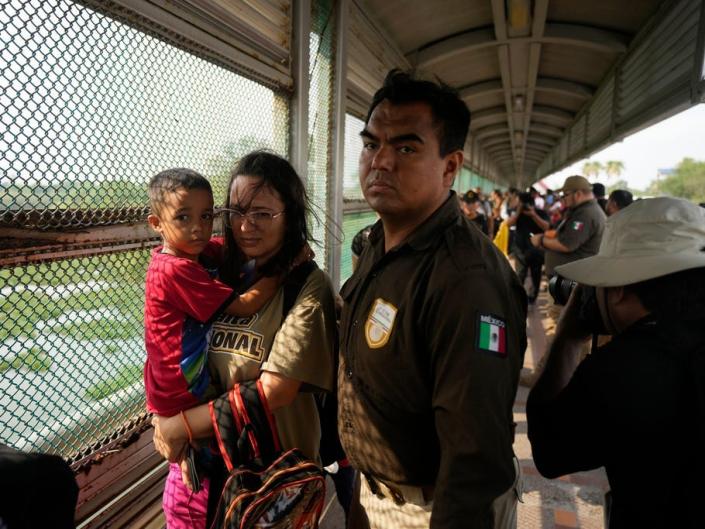-
On Friday, restrictive immigration policy Title 42 — instituted by Donald Trump in March 2020 — expired.
-
Advocates and attorneys told Insider that new measures from the White House are inadequate.
-
That’s because the Biden administration is handling almost all asylum claims through a glitchy app.
The fate of tens of thousands of asylum seekers and the efficiency of the US border now rest on a smartphone application that immigration advocates and migrants alike say is glitchy, slow, and causing mass anxiety among migrants who, as of Friday, have the chance to seek asylum again for the first time in over three years.
Friday marked the official end of Title 42, a public health measure imposed by the Trump administration in March 2020. The measure, criticized for years as inhumane by immigration advocates, gave the US government the ability to close ports of entry to asylum seekers and rapidly deport them — effectively pausing the processing of asylum claims for years and stripping thousands of their international right to seek asylum.
President Joe Biden committed to ending the policy while on the 2020 campaign trail, but ultimately extended its expiry date several times. In recent months, his administration has enacted even more restrictive measures, including allowing migrants to seek asylum at US ports of entry only if they have already sought asylum in any other countries they passed through to reach the US.
Now, the Biden administration has returned to Title 8, a law which, in part, expands access to migrants claiming asylum, while also giving immigration enforcement agencies more tools to rapidly deport people, known as “expedited removals.”
A new ‘digital wall’ is creating its own backlog
But at the core of the Biden administration’s new approach is an electronic asylum processing system which migrants and immigration advocates say is a complete headache to use: the CBP One app.
The app, which launched in January, requires asylum seekers to upload a photo and their personal information to the platform, with a lottery for appointments opening up every day at 10 a.m. until the slots are filled. So far, at least 62,000 people have applied for appointments, and only 800 people have been scheduled for the first appointments to apply for asylum on May 24, according to The New York Times.
The agency says it’s gearing up to open up 1,000 appointment slots per day, per the Times.

The Department of Homeland Security is heavily pushing migrants to use the app, and immigration advocates told Insider that asylum seekers are even being penalized for not using it.
People caught trying to enter the US between ports of entry instead of waiting to be approved for an appointment on the app are being slapped with a 5-year ban on seeking asylum as part of the government’s efforts to promote usage of the technology.
The catch, immigration advocates said, is that the app is borderline unusable for many migrants who have reached the border.
“Nobody that we saw between Matamoros and Reynoso could even open the app today, so imagine the anxiety that they are feeling,” Priscilla Orta, an attorney with Lawyers for Good Government, told Insider on Thursday.
Reports from the border this week described an application that is full of technical glitches, including long loading times as the system is overwhelmed by tens of thousands of people trying to access it at the same time. The app has also struggled to recognize darker skin tones, according to The Guardian.
Nor is the smartphone app accessible to many migrants who have traveled hundreds of miles across dangerous terrain to reach the US border. Some don’t have cell phones, and those who do are struggling to keep a charge or find a connection while stuck in immigration limbo, said Pedro Rios, director of the American Friends Service Committee’s US/Mexico Border Program.
“Essentially it becomes a digital wall,” Rios said of CBP One. “We have a physical border wall and now technology becomes another barrier that migrants are having to find a way around because it just doesn’t work for many of them.”

Advocates working at the border told Insider that on the day Title 42 expired, the app was not working. Thus, even as Title 42 comes to an end, ostensibly offering migrants their first chance to seek asylum in years, many are quickly discovering the obstacles are ever-present, leaving migrants feeling hopeless and desperate, Orta said.
“Imagine you’ve been opening the app every day at 10 a.m. and then you know there’s a shift coming, and on the day of the shift, nothing works,” she said.
The Biden administration did not immediately return Insider’s request for comment.
‘A tough transition’
Department of Homeland Security Alejandro Mayorkas in an interview with MSNBC on Friday acknowledged that the immediate aftermath of Title 42’s expulsion would be “a tough transition,” but emphasized the administration’s plan.
“There’s a right way to seek relief in the United States and a wrong way,” he said. “If individuals do not use those lawful pathways, then they will face tougher consequences at the border.”
“They will be removed if they do not qualify for relief, and they will face, after removal, at least a five-year bar from entry into the United States. And if they try again, they could face criminal prosecution,” he added.
Among the other policies in place to prepare for an expected increase in asylum claims following the end of Title 42 are more regional processing centers; increased powers to asylum officers; and a humanitarian parole pathway for migrants from Nicaragua, Cuba, Venezuela, and Haiti with financial sponsors.
A spokesperson for DHS did not immediately respond to Insider’s request for comment.
Migrants are facing dangerous conditions as they wait for an appointment
The inability to secure an appointment leaves tens of thousands of asylum-seekers stuck in limbo on the other side of the border, where they face a variety of dangers that include dehydration, hunger, unpredictable weather, and violence from Mexico’s increasingly threatening drug cartels.
“You’re telling folks that if you want to seek asylum you have to have an appointment on an app that doesn’t always work,” Orta said. “And then you have the Nueva Generacion Jalisco cartel chasing you and kidnapping you, and telling you that you’re helping to fund their new war.”
Many migrants have no idea the app even exists, let alone the repercussions that await them should they fail to make use of the technology, immigration advocates said.

A Nicaraguan family of eight who attended one of Orta’s “Know Your Rights,” training in Matamoros, Mexico this week had never been given any information about the app as they planned to walk to a US port of entry and apply for asylum.
If they made that honest mistake, and were it not for a network of attorneys and advocates filling in the information blackout, the family would have had their claim rejected at the border with little chance of reapplying for years, Orta said.
“You will never have full freedom and protection in the US all because you innocently walked up to the bridge and had no idea an app existed because you have been fleeing for your life the last few weeks,” Orta added.
While the caustic immigration rhetoric of the Trump administration may be a relic of the past, Rios said the Biden government’s actions toward migrants and asylum seekers are disturbingly similar to his predecessor’s, including the prioritization of an app that leads to limited asylum.
“The fundamental problem is that you’re putting people’s lives on an app,” Orta said. “This is not a Taylor Swift concert.”
Read the original article on Business Insider







